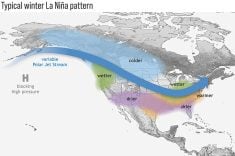When growers see urea prices of $550 per tonne, their knee-jerk reaction is to cut back on nitrogen fertilizer for the upcoming crop year.
That is a big mistake, say agrologists and agronomists.
“The absolute last place you want to cut is nitrogen,” said Elston Solberg of Agri-Trend Agrology Ltd., a Red Deer consulting firm.
That mantra is always true, but it has special relevance in a year full of promise like 2007.
“Western Canada is sitting on a lot of water and water translates into yield potential,” said Solberg.
Read Also

Canadian Food Inspection Agency extends chronic wasting disease control program consultation deadline
Date extended for consultation period of changes to CWD program
In a year like this, when that yield potential is combined with 10-year high commodity prices, it is particularly foolish to scrimp on nitrogen.
Growers intent on keeping input costs in check would be better served to reduce phosphorus, which many farmers don’t realize is the most expensive nutrient they put in the ground. However, nutrient balance is necessary to maximize yield as overall plant health contributes to production.
Farmers tend to look at their nitrogen costs on a per acre basis. A more informed way of making management decisions is by analyzing the cost per unit of production, a calculation fewer than one percent of grain farmers bother to make, said Solberg.
Good hog farmers have their cost per unit calculated down to a nickel and dairy guys down to a fraction of a penny.
“But when it comes to crops, we don’t do that,” said Solberg.
There are plenty of good and free cost calculators on provincial agriculture websites. Farmers who use them may be surprised how little their fertilizer is costing them per bushel.
Solberg has crunched the numbers for canola production on stubble in the black soil zone of Alberta.
To produce an average crop, a farmer in that region would need to spend $1.87 per bu. on total fertilizer costs.
For example, this season a nutritionally balanced 55 bu. per acre hybrid canola crop in the black soil zone of Alberta might require 35 pounds of P205 and 130 lb. of nitrogen, costing about $2 per bushel, according to a Westco nutrient calculator.
Fertilizer forms 45 percent of the value of the crop, with nitrogen forming just 17 percent of the total value.
Considering that canola is selling for $8 per bu., it is a good gamble to load up on the nitrogen this year.
“It’s a relatively small incremental cost to get you to higher yield potential and higher profit,” said Solberg.
He isn’t the only expert dishing out that advice.
John Mayko, senior agronomist with the Canola Council of Canada, said by cutting nitrogen rates, farmers may also end up slicing their profits.
He worries canola growers who are “sticker-shocked” by rising fertilizer prices will abandon sound farm management practices to avoid spending what could easily amount to $50 per acre on nitrogen. That would be unwise.
“Nitrogen is the main driver for yield, especially in canola,” said Mayko.
A canola farmer who reduces nitrogen application rates by 10 lb. per acre can only afford to lose three quarters of a bu. in yield – any more and he starts losing money.
Another thing to consider is that yield increases and declines are even more pronounced with new hybrid varieties, which are more sensitive to nitrogen applications than open pollinated varieties, according to research conducted by Agriculture Canada and Westco Fertilizer.
Mayko said if growers take one message away from what he is saying, it is that they should get an accurate soil test done this spring, which means probing to a depth of 24 inches.
He has a hunch that with last year’s impressive yields, there may be a nitrogen deficiency in many fields.
If test results prove him wrong, growers can save themselves the expense of paying for a high priced input.















